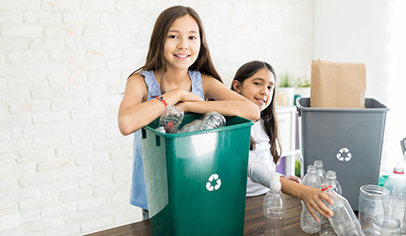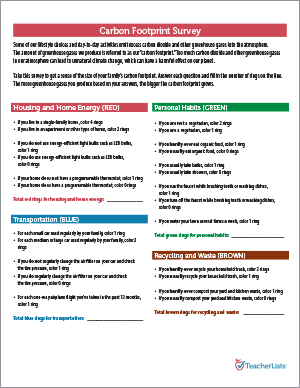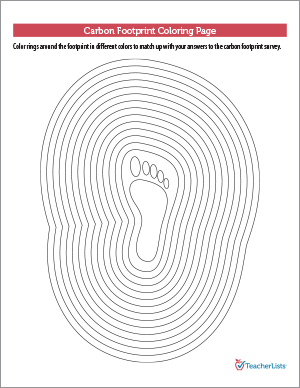
Antonio Diaz/123RF
Learning area: Science
Time commitment: Quick (30 minutes or less)
Best for: Grade 2, Grade 3, Grade 4, Grade 5, Grade 6
Figure out the size of your family’s carbon footprint to learn how much impact you have on the environment. Families can help reduce their carbon footprint by focusing on four major areas that generate excess carbon dioxide: housing and household energy use, transportation, personal habits, and recycling.
Materials:
- carbon footprint survey, one per student
- carbon footprint coloring page, one per student
- crayons, markers, or colored pencils in 4 colors (red, blue, green, brown; or other representative colors)
Instructions:
- Complete the carbon footprint survey. This will determine the number of rings you need to add to your footprint.
- Figure out how many rings you need to add for each section, then color the suggested number of rings in the designated color on the carbon footprint coloring page. (Start with the ring closest to the footprint symbol.)
- Review the list of ways you can reduce your carbon footprint and choose a few of them to try. How big a difference can you make in your family’s carbon footprint?
Learn more:
Energy from the sun drives the Earth’s weather and climate. The planet absorbs some of the energy it receives from the sun and sends out the rest back toward space. But certain gases in the atmosphere, called greenhouse gases, absorb some of the energy radiated from the Earth and trap it in the atmosphere. These gases act as a blanket, making the Earth’s surface warmer than it otherwise would be. Greenhouse gases are produced naturally and are an important part of Earth’s atmosphere.
In the past 100 years or so, humankind has created machines, factories, and vehicles that increase the amount of greenhouse gases in our atmosphere. This increased level of greenhouse gases means more heat is held in the atmosphere. If the planet gets too warm, then oceans, air, and the ground could overheat. This could upset the delicate balance that sustains life.
Climate change caused by excess greenhouse gases and a big carbon footprint can cause:
- Heat waves that damage crops, stress livestock, and make life difficult for people.
- More air pollution, which is linked to allergies, asthma, and other health problems.
- Severe storms and flooding because of higher sea levels.
- Loss of habitat as the climate changes, particularly in Arctic regions.
Whether we realize it or not, we all emit carbon dioxide, one of the greenhouse gases, through our day-to-day activities. The amount we emit is referred to as our “carbon footprint.” The more carbon dioxide that comes from each of us as a result of the choices we make, the bigger the footprint.
Carbon Footprint Survey
Some of our lifestyle choices and day-to-day activities emit excess carbon dioxide and other greenhouse gases into the atmosphere. The amount of greenhouse gases we produce is referred to as our “carbon footprint.” Too much carbon dioxide and other greenhouse gases in our atmosphere can lead to unnatural climate change, which can have a harmful effect on our planet.
Take this survey to get a sense of the size of your family’s carbon footprint. Answer each question and fill in the number of rings on the line. The more greenhouse gases you produce based on your answers, the bigger the carbon footprint grows.

Click image to download carbon footprint survey PDF
Carbon Footprint Coloring Page

Click image to download carbon footprint coloring page PDF
What can you do to reduce the size of your carbon footprint?
Housing and home energy (rings in RED)
Energy-efficient light bulbs such as LED bulbs consume less electricity than conventional incandescent light bulbs. Change your household fixtures to LEDs and you’ll save money on your household energy bills in addition to reducing your carbon footprint.
A programmable thermostat turns your home’s heating or air-conditioning up and down automatically depending on the time of day and whether people are at home. When your home’s energy system is working efficiently, it wastes less energy.
Transportation (rings in BLUE)
Drive compact cars that get a lot of miles on a single tank of gasoline. All gasoline-powered automobiles emit carbon dioxide, but the larger the car, the more carbon dioxide is emitted.
Cars that are properly maintained are more energy-efficient. Regularly change the air filter and make sure the tires are always properly inflated to keep your vehicle running as efficiently as possible.
Personal Habits (rings in GREEN)
Growing, processing, packaging, delivering, and distributing food requires energy from farms, factories, trucks, grocery stores, and more. Because a vegetarian diet doesn’t include meat, the carbon footprint tends to be smaller.
Buy organic when possible. The production of organic food puts less stress on the environment.
Turn faucets off between rinsiings so you use only the amount of water you really need. Water that goes down our drains and sewers must be processed through water treatment plants, even if the water is clean.
Recycling and Waste (rings in BROWN)
Recycling keeps excess waste out of landfills and trash incinerators.
Composting keeps kitchen and garden waste out of the trash and encourages natural gardening practices.
Pro tip:
Manage your classroom supply lists on TeacherLists. Lists can be uploaded in seconds and shared with parents so they can shop quickly and conveniently. Learn more about TeacherLists.



